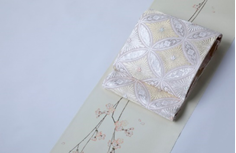F.NO.2 Phenology calendar on 14th April
Kimono custom to write “April 1st” and read “Watanuki”
Yoshie Doi
In the olden days, it was customary to pull out cotton on April 1st for kimono, which is a traditional Japanese costume. When you think about cotton, you might think of cotton to decorate a Christmas tree. It’s fluffy. Some people may think about cotton as a futon. Some may think of the fluffy kimono in the bride’s uchikake (Japanese bride’s Kimono dress) .
In the olden days, around December, they put cotton in a lined kimono to keep it warm and survived the cold winter. In June, it will be a single garment without lining. By the time of midsummer, they began to wear thin cloths called Ryo and Sha. In winter, there is also a cotton-filled kimono called Tanzen. I remember my dad wearing it a lot.
The long-standing custom of kimono, which is adjusted according to the season, coined the term Watanuki (April 1st).
In the season of changing clothes, in the old days, they pulled out the thread, put it back in a piece of cloth, and washed it with water every time they remade it. When the fabric is cut for a long time, it stretches, so I pull out the thread and wash it again. In the days when there was no soap, they used to devise a way to untie the kimono and return it to the original cloth for washing. As for the SDGs themselves, it is said that there were a lot of second-hand clothing stores and the most popular type of store in the Edo period.
In Japan, where there are plenty of water-rich washareas, it was easy to rewash, but in the West, some clothes were not washed for 10 years, so I was surprised when I had read the literature.
Unlike Western clothes, straight-line kimonos can be shared or remade and handed over to someone, which is an eco-friendly way of making clothes.
 |
 |
Awase : cherry blossom pattern kimono
Photo courtesy : Kyogofuku 28 (Futaya)
